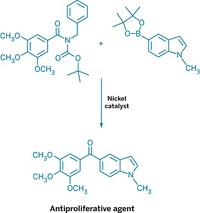Advertisement
Grab your lab coat. Let's get started
Welcome!
Welcome!
Create an account below to get 6 C&EN articles per month, receive newsletters and more - all free.
It seems this is your first time logging in online. Please enter the following information to continue.
As an ACS member you automatically get access to this site. All we need is few more details to create your reading experience.
Not you? Sign in with a different account.
Not you? Sign in with a different account.
ERROR 1
ERROR 1
ERROR 2
ERROR 2
ERROR 2
ERROR 2
ERROR 2
Password and Confirm password must match.
If you have an ACS member number, please enter it here so we can link this account to your membership. (optional)
ERROR 2
ACS values your privacy. By submitting your information, you are gaining access to C&EN and subscribing to our weekly newsletter. We use the information you provide to make your reading experience better, and we will never sell your data to third party members.
Synthesis
Organofluorine Family Expands Radically
Radical addition reaction leads to a new class of bioactive heterocycles containing a difluoromethylsulfide group
by Stephen K. Ritter
March 10, 2014
| A version of this story appeared in
Volume 92, Issue 10

Synthesis of a difluoromethyl xanthate compound has enabled a team of chemists to devise a convergent pathway to a new class of bioactive heterocyclic compounds. The difluorothiochromans, as they are called, could serve as building blocks to increase the diversity of heterocycle-based drugs. Pierre Salomon and Samir Z. Zard of École Polytechnique, in France, originally prepared the xanthate as part of the Zard group’s metal-free strategy for generating fluorine-containing radical species for addition to terminal alkenes. With the new xanthate in hand, the researchers ran a series of reactions coupling the compound with variously substituted alkenes. They discovered that further treating the adducts with a peroxide leads to a cyclization step to form the bicyclic thiochromans as shown (Org. Lett. 2014, DOI: 10.1021/ol5002939). Fluorine chemistry is enjoying a renaissance as chemists create new methods for preparing drug candidates, agrochemicals, and electronic materials. But work on fluorinated sulfides has been limited, Zard notes. Thiochromans are already used to treat acne, psoriasis, and breast cancer, he says, so the fluorinated thiochromans might serve to improve existing drugs or lead to new drugs for treating other diseases.





Join the conversation
Contact the reporter
Submit a Letter to the Editor for publication
Engage with us on Twitter